Just Bead It! Sealing the Point Contact Location
UL Systems that permit point contact will often specify a bead of sealant to be applied at the point contact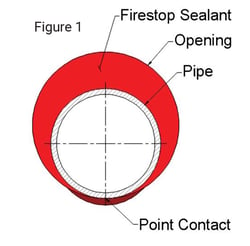 location between penetrant and periphery of the opening. The UL Systems somewhat generically list the sealant applied at that location as a bead having a minimum diameter. This can sometimes cause confusion.
location between penetrant and periphery of the opening. The UL Systems somewhat generically list the sealant applied at that location as a bead having a minimum diameter. This can sometimes cause confusion.
To begin, let’s very quickly talk about annular space. UL Systems will always indicate if the penetrant must be centered within the opening (i.e. concentric installation) or if it can be installed eccentrically (i.e. offset). Some systems permit the penetrant to be installed either concentrically or eccentrically. The resulting gap between the penetrant and the periphery of the opening is the annulus or annular space. 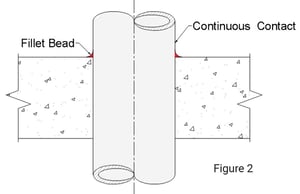 Systems will sometimes provide a range of annular space such as minimum 0” to maximum 2”. When it comes to listings, there are two conditions where the penetrant will contact the periphery of the opening (i.e. 0” annular space). These are described as “point contact” (Figure 1) and “continuous point contact” or “continuous contact” (Figure 2). There is a distinction; if the system allows point contact, the penetrant can contact a single side of the opening. Of course, the amount of the penetrant that may contact the periphery of the opening can vary based on the diameter or dimensions of the penetrant. Think about it in terms of a smaller pipe in a larger opening or a larger pipe in a proportionally tighter opening; the amount of contact is going to vary, but it still results in a single point of contact. Continuous contact, by contrast, is where the penetrant (e.g. a pipe or conduit) contacts the opening on all sides (e.g. 360-degree contact for round object in a round opening). A system that lists “point contact” does not permit “continuous contact” unless explicitly stated.
Systems will sometimes provide a range of annular space such as minimum 0” to maximum 2”. When it comes to listings, there are two conditions where the penetrant will contact the periphery of the opening (i.e. 0” annular space). These are described as “point contact” (Figure 1) and “continuous point contact” or “continuous contact” (Figure 2). There is a distinction; if the system allows point contact, the penetrant can contact a single side of the opening. Of course, the amount of the penetrant that may contact the periphery of the opening can vary based on the diameter or dimensions of the penetrant. Think about it in terms of a smaller pipe in a larger opening or a larger pipe in a proportionally tighter opening; the amount of contact is going to vary, but it still results in a single point of contact. Continuous contact, by contrast, is where the penetrant (e.g. a pipe or conduit) contacts the opening on all sides (e.g. 360-degree contact for round object in a round opening). A system that lists “point contact” does not permit “continuous contact” unless explicitly stated.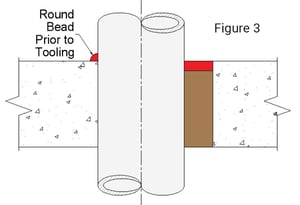
When point contact exists, it should be sealed with a bead of sealant to ensure that the seal is a continuous membrane. This also helps to prevent the free passage of hot gases and smoke, and for purposes of ASTM E814 and ANSI/UL1479, it allows the system to pass the hose stream portion of the test by restricting the passage of water beyond the unexposed side.
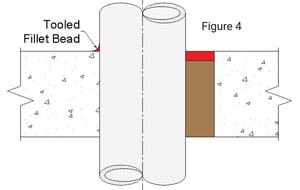 Applying a bead of sealant seems like an easy thing, but when it comes to ensuring compliance, the vagueness of the description in the listings can
Applying a bead of sealant seems like an easy thing, but when it comes to ensuring compliance, the vagueness of the description in the listings can
sometimes make this task difficult. So what kind of bead is required? According to the UL Systems, it is often stated to be a minimum diameter (Figure 3). And this would be true if the sealant were not tooled. More accurately, the bead applied at point contact is a fillet bead (Figure 4). The bead is applied initially to a specific diameter (e.g. ¼”), but it is then tooled to form the fillet bead. For water-based products, this is often done with a swipe of the finger. For silicones or urethanes that may be stickier, a tooling knife or even a plastic spoon may be used. Often the illustrations will show the desired profile, which is more triangular when viewed as a cross-section. If an inspector wanted to measure the point contact bead, they might cut into it to verify the bond between pipe and substrate. In the case of a ¼” bead, it might more accurately measure as a ¼” x ¼” fillet bead. Keep in mind that it may be unnecessary to destructively test that portion of the seal. Often bond can be measured by simply pushing a thumb into the seal at that location to ensure that it stays adhered to both penetrant and substrate.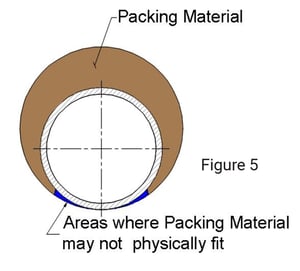
One last note… while tooling is a good practice, it also may not be required. If the installer applied a continuous bead of sealant that adhered to
both penetrant and substrate, it would certainly satisfy the test requirements. It might not look as aesthetically desirable, but functionally, it would still perform.
Systems with Packing Material
Any discussion on point contact will invariably trigger the discussion on packing materials. Some systems require a packing material as an integral component. A common packing material is mineral wool, although glass or ceramic fiber may also be used in some systems. To confirm, there is no packing material behind the penetrant at the point contact location. The packing material is often wedged up as close as possible to the sides of the penetrant where it contacts the periphery of the opening. In some cases, the prescribed depth of packing material at these locations may be less than specified in the system due to the physical limitations of hand-packing the material into said location. Additionally, when doing an inspection of the packing material prior to sealant installation, a void space may be observed (Figure 5). This small void space is covered with the sealant that is applied as a fillet bead atop it.






